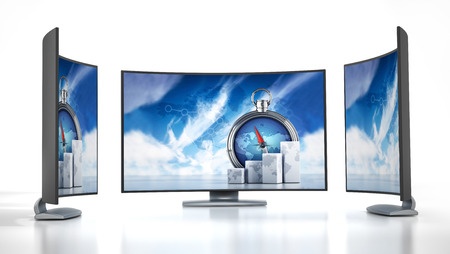Curved TV – Curve your Enthusiasm
The last few years have seen some seismic changes in TV technology – from the introduction of Full HD, 3D, Smart TV, Ultra HD / 4K, the final phasing out of the Analogue signal and the demise of Plasma screens to name but a few.
So where to next? The last season has seen a number of curved TVs hitting the market. Granted, they definitely look the part and stand out from the crowd – but are they anything more than just another marketing angle from manufacturers aimed at the consumer who just needs to have the latest gimmick?

Getting your Angles right
The angle (pardon the pun) from the boys and girls at Samsung and LG is the notion that Curved TVs provide a better, more immersive viewing experience. But how or what makes a curved TV better than a flat one when it comes to your viewing experience?
Firstly, the curved out shape of the edges of the screen reduces reflection, simply by eliminating certain angles from which they can be created. This is a great feature for LCDs, because over the years the technology has grown from one whose Achilles heel has always been contrast. As todays screens produce excellent dark image detail and great black reproduction – you don’t want that ruined by light reflections off the screen.
Secondly, the viewing experience is improved for those watching TV from off-centre. The curve of the screen helps in making all parts of the image feel the same distance away from you, equalizing the far part of the screen to the closer part.
The curved shape also helps the viewer retain a more uniform distance to all parts of the image when they are sitting centrally. Again, the curve of the screen is aiding in making all parts of the image feel the same distance away from your eyes.
This “uniformity” of distance from all parts of the screen – the edges and the centre – to the viewer’s eyes is something which Curved TV manufacturers are pushing the benefits of. Put Simply, the closer you are to an image, the bigger it feels, right? So a curve in the sides of the screen is bringing that part of the image closer to you, giving a perceived size increase.
Much of the marketing campaign from Curved TV manufacturers are also targeted at the “Immersiveness” the Curved screen provides – that is uniform viewing distance, and the lack of viewing distortion at the edges. When we look out at the world in real life, we don’t perceive it as just a flat image. Our eyes are round, and we have peripheral vision, so we are aware of the world around our sides too. By curving the edges of the screen towards us, Curved TVs try to replicate our real life vision, making us feel more immersed in what we’re watching.
So, what are the downsides?
Obviously the first one has to be cost. Just as every single new technology preceding this comes at a huge premium, and price starts to wane as production scale kicks in – right now we’re at that peak where if we want the latest trend – we are paying more than we should for it.
Secondly, wall mounting a curved TV can look very awkward to say the least. The whole point to Wall mount a TV is to achieve that neat, flat look which is very pleasing to the eye – almost like an artwork. But try to imagine a curved TV mounted on the wall, with its edges curving away from the wall. It can look very odd especially if you walk in to the TV room from the side.
Also, if you have any light source directly opposite your Curved TV, like a balcony or a window – then you don’t just get the normal reflection you would on a traditional Flat screen TV. The curve of the screen tends to distort the reflection across the whole of the screen – so positioning becomes a paramount factor in deciding if a Curved TV is right for you.
Also while the whole immersion and equidistant benefits of a Curved TV can be considered as benefits, too much of an angle to a Curved TV will provide you with the exact opposite – a distorted image. If you sit at such an angle (say you have friends over watching the game) that the closer side of the screen bends away from you – that will cause you to have a very poor viewing experience.
So along with Ultra-modern aesthetics, there also seem to be some very real benefits to Curved TVs. But let’s face it – before we were told by Samsung and LG that we were never fully immersed watching TV, and the fact that we were sitting at a non-equidistant angle to all parts of our screen meant we were watching a distorted image – did we really care? Are those facts alone going to make us want to fork out hundreds and hundreds of dollars more for a Curved TV? Or will we part with our dosh because a Curved TV just looks so sexy?
As long as you weigh in the cons of a Curved TV for your situation, and you don’t mind forking out the cash for an Ultra-modern conversation starter – then a Curved TV might be what you’ve been looking for!

